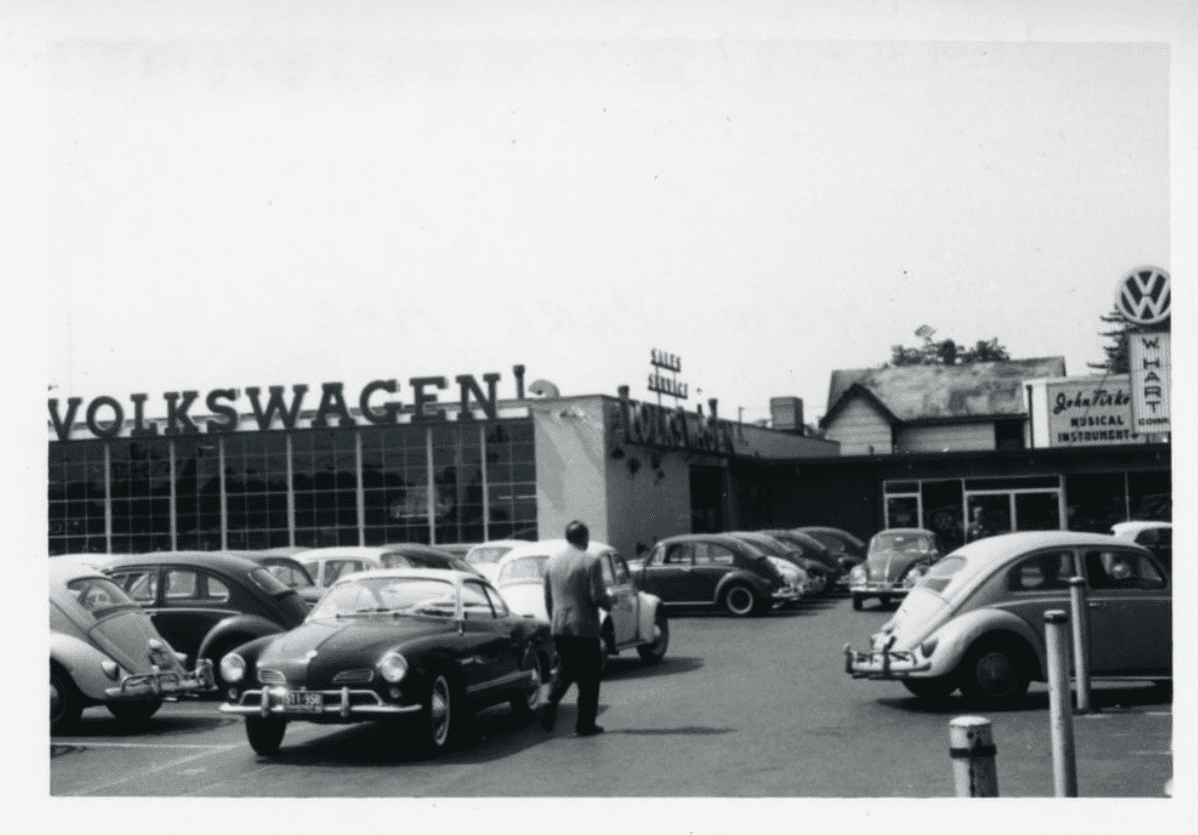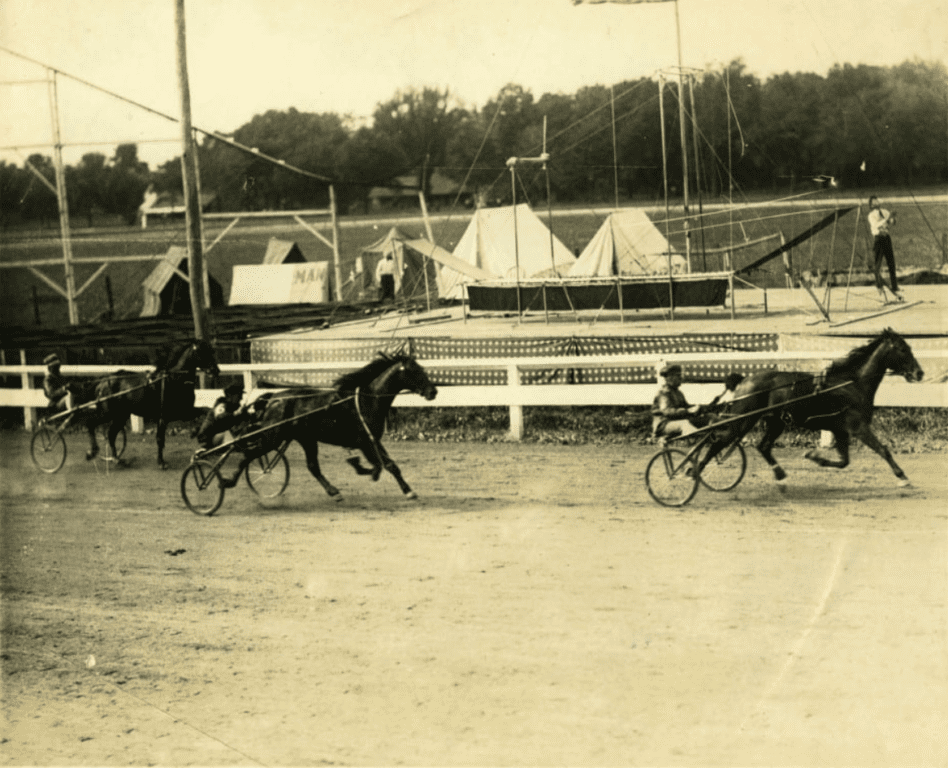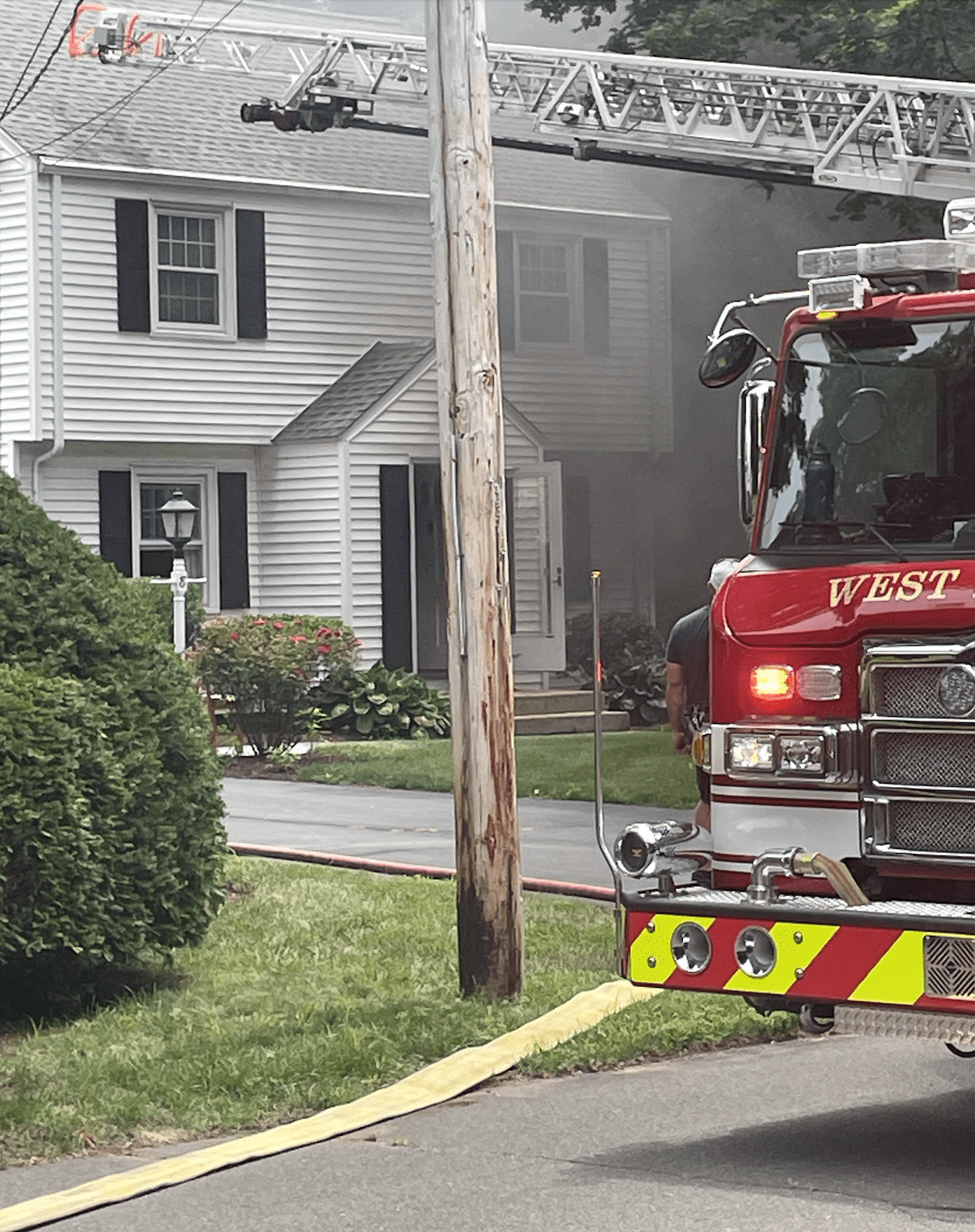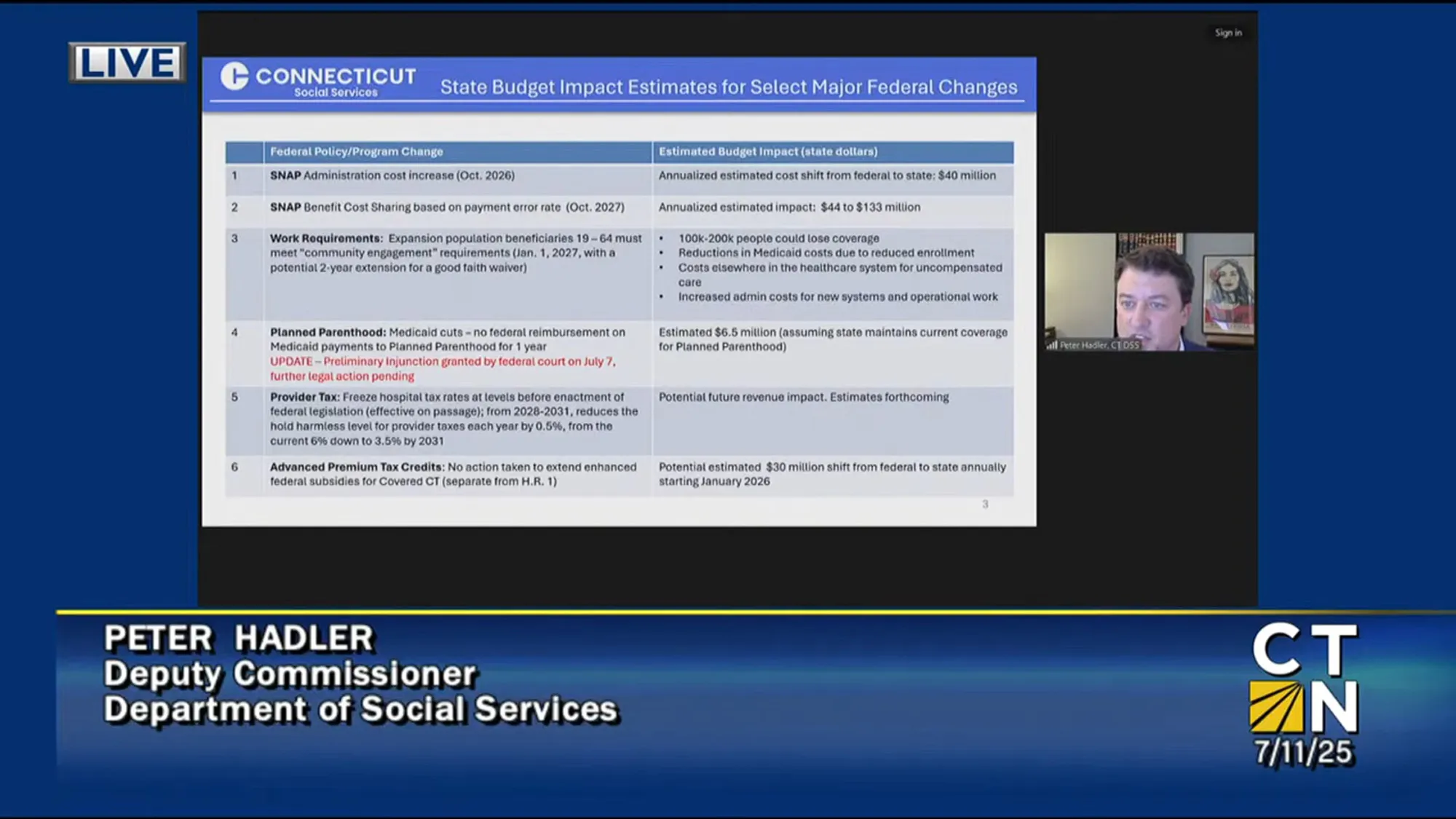From the West Hartford Archives: New Park and Flatbush

Audio By Carbonatix

W. Hart Volkswagen at 470 New Park Avenue. Photo courtesy of Noah Webster House & West Hartford Historical Society
Historian Jeff Murray takes a look into West Hartford’s past to uncover some surprising information, stir up some memories, or reflect on how much life has changed – or hasn’t changed at all. Enjoy this week’s ‘From West Hartford’s Archives’ …
By Jeff Murray
The W. Hart Volkswagen dealership pictured here was located at 470 New Park Avenue at the southeast corner of Flatbush Avenue. It opened on Feb. 22, 1960 and was built on the site of two houses from the 1800s.
This section of New Park Avenue was originally laid out in the early 1870s from Flatbush Avenue to New Britain Avenue and ran parallel to the railroad. It was named after the new Charter Oak Park horse racing track in 1873, which was developed on the south side of Flatbush Avenue where Home Depot and BJ’s are today.
Once it was improved, the avenue became an easy route to the Oakwood Hotel, which was built in the mid-1870s in front of Charter Oak Park. The northern half of this avenue, from Talcott Road north, was dominated by houses that were built in the following years to accommodate people who moved to the area, mostly from Parkville in Hartford.
The close proximity to the railroad made living in Elmwood and working in Hartford an ideal situation for many working class people. It was also the site of many social events – the Connecticut Agricultural Society held the annual state fair every September in the 1880s. As a result, this neighborhood became associated with the Charter Oak Park race track and horse racing in general.
William Brown Smith became the face of that trend in this area. Born in 1832, he became interested in horses at a young age and after a stint as a tailor in the 1860s, he devoted his entire time to them. He bought up most of the land on the west side of New Park Avenue in front of the race track and constructed stables. One of the horses he owned was named “Thomas Jefferson” – an idol of the era. His biggest wins were in 1874, the year the park opened, and the following year.
When Jefferson died in 1891, Smith had a monument put up and the street extending west from New Park Avenue to the park was named Jefferson Avenue in his honor. Jefferson had been taken care of by famous horseman Matt Darcy, who lived on the property at the park for many years. If that name sounds familiar, Darcy Street was named after him for his impact to the community. Therefore, the horse racing that defined the area in the late 1800s is now the legacy of the streets named after it, both horse and human alike.

Horse racing at Charter Oak Park; Photo courtesy of Noah Webster House & West Hartford Historical Society
Smith’s wife was Virginia Thrall, a city missionary in Hartford and the founder of the Home for Incurables in Newington, now the Connecticut Children’s Medical Center. Thrall was a great reflection of the social welfare side of the early American Progressive Era, in which activists sought to address the ills of child poverty and the poor. As a city missionary, she instituted a loan system, a sewing class, reading circle, singing school for boys and girls, and other organizations in the 1870s.
Hartford, like many American cities after the Civil War, faced a wide range of problems that came with industrialization: pollution, unclean water, filthy tenement housing, and inefficient government. Thrall was heavily engaged in creating a support system for children affected by this collection of issues, most notably illegitimate children. She founded the first free kindergarten in Connecticut in the early 1880s, but her alleged involvement in a more controversial practice became a cause for concern among some people.
In 1892, Hartford’s government investigated the practice of “baby farming,” in which someone would care for a child in exchange for money. The investigation was prompted after Thrall applied for someone to be guardian of an illegitimate infant of a mother who had just died and had been staying with her. Hartford authorities began questioning why she was involved in helping find guardianship.
It opened up a wider inquiry into her potentially operating a baby farm for illegitimate children – was she funneling babies through a support system for charity or for money was the leading question. The investigator followed up a lead at a house on New Park Avenue across from Darcy Street owned by a Lydia Sammis, a widow who had bought the house from Virginia’s son Oliver. She admitted to boarding children on and off for Virginia for eight years, all under the age of 10.
In the New Park Avenue house, in which she had been living only since 1891, she said she boarded two babies, one for a mother whose marriage was forced and the husband was not involved in care and the other for an unwell mother. Both cases were illegitimate children in which the fathers had paid for the service, and all were allegedly through Virginia as intermediary. This secret network of boarding and adoption of illegitimate children wasn’t necessarily illegal at face value, but it prompted much concern for the sake of transparency. This practice was conducted at a time when there were not many resources for illegitimate children to be cared for and funneled to suitable families.
Thrall might have said it was a necessary evil that it be done in this manner, but she was pushed to resign that December as city missionary. That a New Park Avenue house was one of the sites visited provides a snippet of what was happening under the surface in the Hartford area. It also meant that West Hartford was not immune to these same troubles, even if it was just as a conduit.
New Park Avenue is one of the best examples of a street that developed with two sides: a retreat for the wealthy and playground for the townspeople, and the seedy underbelly that came with it. The boys in the neighborhood were poorer and trended more towards hooliganism than other areas of West Hartford, a product of the socioeconomic background of the avenue.
In 1899, boys played “tic-tac-toe” by smashing a window of a house at 472 New Park Avenue, occupied by Emily Loomis Hamilton, her daughter Emily, and her son from a previous marriage, Charles L. Blake. This is the house that can be seen in the back of this week’s photo. Another boy threw vegetables at a girl rolling a baby carriage on the sidewalk.
The area was rife with liquor selling – the brickyard men down the road and Charter Oak Park visitors were a steady customer base. Police raids were common for many decades into the 1920s. A group of Romani, known then as “gypsies”, camped along New Park Avenue with 20 horses for several weeks in 1906 and had to be ordered out by the town just in time for the opening of Luna Park a short distance south.
New Park Avenue was consistently in bad shape and drunken fights between immigrant communities that made up the working-class population broke out all the time. There were constant complaints of outward domestic abuse, gambling, cockfighting, and oppressive dust clouds that filled the air from cars that raced at the track.

View of the neighborhood in 1923 – the Sammis house is at 478/480 New Park Ave, Sanborn Map Company
The development of the area, however, continued steadily for several decades: Darcy Street and Jefferson Avenue were built up, Spencer Turbine Company built a factory nearby opposite Jefferson, and more commercial blocks were built across the street in the 1940s. Pratt & Whitney built a factory in 1940 on the former race track site.
The two houses that were at the southeast corner of Flatbush Avenue and New Park Avenue were removed in the 1950s to make way for the W. Hart Volkswagen dealership at 470 New Park Avenue. G. Wilbur Hart had originally operated W. Hart Buick since 1940 before leaving the industry for a short period. Upon his return in 1958, he opened a Volkswagen dealership on the Silas Deane Highway before expanding in 1960 to this corner in West Hartford. In 1972, it became Bill Barry Volkswagen under William Barry until 2004 when it was rebranded as Volkswagen of West Hartford.
The dealership closed down and was demolished in the fall of 2009. The land had been acquired by eminent domain from the state for the CTfastrak busway station, which was built along the railroad right-of-way here. Flatbush Avenue was raised over the busway next door.
Opened in 2015, the busway continues to serve thousands of people in the area and beyond from Hartford to New Britain. From a road laid out to reach a horse racing track and hotel to a bustling residential street to a commercial hotspot and finally to a hub for mixed-use housing and mass transit, New Park Avenue continues to show its versatility as it marches through time.

The Flatbush Avenue CTfastrak station is now located on the site of the former W. Hart Volkswagen. Google Street view
Jeff Murray was born and raised in West Hartford and has been involved with the Noah Webster House & West Hartford Historical Society since 2011 when he was a high school student and won the Meyer Prize for his essay on local history. Jeff routinely volunteers as local history researcher uncovering information for numerous museum programs such as the West Hartford House Tour and West Hartford Hauntings. Jeff works as a data analyst at Pratt & Whitney.
Like what you see here? Click here to subscribe to We-Ha’s newsletter so you’ll always be in the know about what’s happening in West Hartford! Click the blue button below to become a supporter of We-Ha.com and our efforts to continue producing quality journalism.




This is so interesting. Usually the New Park focus is on the racetrack and Luna Park. You have added some context that was new to me. I bet Virginia Thrall was a big story at the time. I’ve read some of the School Committee minutes from long ago and the was a lot of focus on building and running Charter Oak Elementary. The school appears to be used for neighborhood programs such as the “Americanization” program to help teach English and help with translating things like how to pay your taxes, concern for those who lived in nearby ‘factory’ housing. We tend to think of our history as one of the evolution of an upper middle class WASP suburb, and while that is certainly one component, we have always been a quite diverse community on all different kinds of levels. We think today’s social challenges are new and unique but in many ways we have seen them all before. Maybe they are not problems to be “solved” but processes to grow through. Ramble over, lol!
Thanks so much for you work and insight.